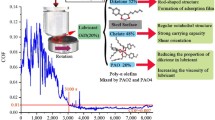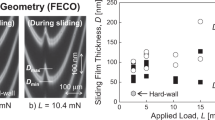Abstract
In this paper, the lubrication mechanism of fatty acids is revisited with a new approach combining experimental and computational chemistry studies. The lubricating properties of single and mixtures of stearic, oleic and linoleic acids in a synthetic Poly-Alpha-Olefin base oil (PAO4) on iron oxide surface are investigated under mixed boundary regime with temperatures from 50 °C up to 150 °C. Low friction coefficient (about 0.055) with no visible wear is reported in the presence of single stearic acid at high temperature. This lubricating behavior is inhibited in the presence of unsaturated fatty acids highlighting an anti-synergic effect of a saturated/unsaturated mixture, especially at 150 °C. To understand the anti-synergic effect and the adsorption mechanism of these molecules, molecular dynamic (MD) and quantum chemistry simulations are performed to evaluate their diffusion coefficient in PAO4 and their adsorption mechanism on iron oxide at different temperatures. MD simulation results show a faster diffusion toward the surface for unsaturated fatty acids than for saturated fatty acid at all the studied temperatures. This means that unsaturated molecules arrive and mainly adsorb before stearic acid on the surface leading to a tribological behavior of the mixture characteristic of the unsaturated molecule. Computational chemistry suggests that all fatty acids (saturated and unsaturated) adsorption mechanism is due to the chemisorption of the carboxylic group on iron oxide surface with no desorption up to 150 °C.











Similar content being viewed by others
References
Anghel, V., Cann, P.M., Spikes, H.A.: Direct measurement of boundary lubricating films. Tribol. Ser. 32, 459–466 (1996)
Bowden, F.P., Tabor, D.: The friction and lubrication of solids, chapter X, Oxford Classic Texts in the Physical Science (2001)
Lim, M.S., et al.: Adsorption and desorption of stearic self-assembled monolayers on aluminum oxide. Langmuir 23, 2444–2452 (2007)
Fischer, D.A., Hu, Z.S., Hsu, S.M.: Molecular orientation and bonding of monolayer stearic acid on a copper surface prepared in air. Tribol. Lett. 3, 41–45 (1997)
Yea Y.S.: Electrochemical study of the interaction between fatty acid and oxidized copper. Tribol. Int. 30, 423–428 (1997)
Russel, J.A., Campbell, W.E., Burton, R.A., Ku, P.M.: Boundary lubrication behavior of organic films at low temperature. ASLE Trans. 8, 48–58 (1965)
Ratoi, M., Anghel, V., Bonvington, C., Spikes, H.A.: Mechanism of oiliness additives. Tribol. Int. 33, 241–247 (2000)
Jahamir, S., et al.: Chain length effects in boundary lubrication. Wear 102, 331–349 (1985)
Zisman, W.A.: Durability and Wettability Properties of Monomolecular Films on Solids, Friction and Wear, pp. 110–148. Elsevier, Amsterdam (1959)
Lundgren, S.M., et al.: Unsaturated fatty acids in alkane solution: adsorption to steel surfaces. Langmuir 23, 10598–10602 (2007)
Lundgren, S.M., Ruths, M., Danerlöv, K., Persson, K.: Effects of unsaturation on film structure and friction of fatty acids in a model. J. Colloid Interface Sci. 326, 530–536 (2008)
Sahoo, R.R., Biswas, S.K.: Frictional response of fatty acids on steel. J. Colloid Interface Sci. 333, 707–718 (2009)
Campen, S. et al.: On the increase in boundary friction with sliding speed. Tribol. Lett. 48(2), 237–248 (2012)
Simie, R., Kalin, M.: Adsorption mechanisms for fatty acids on DLC and steel studied by AFM and tribological experiments. Appl. Surf. Sci. (2013). doi:10.1016/j.apsusc.2013.06.131
Fox, N.J., Tyrer, B., Stachowiak, G.W.: Boundary lubrication performance of free fatty acids in sunflower oil. Tribol. Lett. 16, 275–281 (2004)
Castro, W., Weller, D.E., Cheenkachorn, K., Perez, J.M.: The effect of chemical structure of basefluids on antiwear effectiveness of additives. Tribol. Int. 38, 321–326 (2005)
Siniawski, M.T., Saniei, N., Adhikari, B., Doezema, L.A.: Tribological degradation of two vegetable-based lubricants at elevated temperatures. J. Synth. Lubr. 24, 101–110 (2007)
Onodera, T., et al.: A computational chemistry study on friction of h-MoS2. Part I. Mechanism of single sheet lubrication. J. Phys. Chem. B 113, 16526–16536 (2009)
Onodera, T., et al.: A computational chemistry study on friction of h-MoS2. Part II. Friction anisotropy. J. Phys. Chem. B 114, 15832–15838 (2010)
Buehler, M.J.: Atomistic Modeling of Materials Failure, pp 38–40. Springer, New York (2008)
Morita, Y., et al.: Development of a new molecular dynamics method for tribochemical reaction and its application to formation dynamics of MoS2 tribofilm. Jpn. J. Appl. Phys. 47(4), 3032–3035 (2008)
Delley, B.J.: From molecules to solids with the Dmol3 approach. J. Chem. Phys. 113, 7756 (2000)
Vosko, S.H., Wilk, L., Nusair, M.: Accurate spin dependent electron liquid correlation energies for local spin density calculations: a critical analysis. Can. J. Phys. 58, 1200 (1980)
Saunders, M.G., Voth, G.A.: Coarse-graining method for computational biology. Ann. Rev. Biophys. 42, 73–93 (2013)
Woodcock, L.V.: Isothermal molecular dynamics calculations for liquid salts. Chem. Phys. Lett. 10, 257 (1971)
Onodera, T., et al.: Development of a quantum chemical molecular dynamics tribochemical simulator and its application to tribochemical reaction dynamics of lubricant additives. Modell. Simul. Mater. Sci. Eng. 18, 034009 (2010)
Ewald, P.P.: Die berechnung optischer une elektrostatische gitterpotentiale. Ann. Phys. 64, 253–287 (1921)
Carzaferri, G., Forss, L., Kamber, I.: Molecular geometries by the extended Hückel molecular orbital method. J. Phys. Chem. 93, 5366–5371 (1989)
Smits, G.: Measurement of the diffusion coefficient of free fatty acid in groundnut oil by the capillary-cell method. J. Am. Oil Chem. Soc. 53(4), 112–124 (1976)
Mansfield, W.W.: The spontaneous emulsification of mixture of oleic acid and paraffin oil in alkaline solution. Aust. J. Sci. Res. Ser. A Phys. Sci. 5, 331 (1953)
Toshitaka, F. et al.: Diffusion coefficients of linoleic acid methyl ester, Vitamin K3 and indole in mixtures of carbon dioxide and n-hexane at 313.2 K, and 16.0 MPa and 25.0 MPa. Fluid Phase Equilib. 164(1), 117–129 (1993)
Author information
Authors and Affiliations
Corresponding authors
Rights and permissions
About this article
Cite this article
Loehle, S., Matta, C., Minfray, C. et al. Mixed Lubrication with C18 Fatty Acids: Effect of Unsaturation. Tribol Lett 53, 319–328 (2014). https://doi.org/10.1007/s11249-013-0270-3
Received:
Accepted:
Published:
Issue Date:
DOI: https://doi.org/10.1007/s11249-013-0270-3




